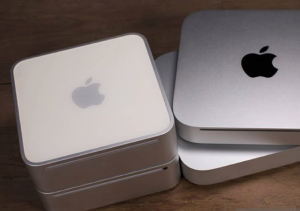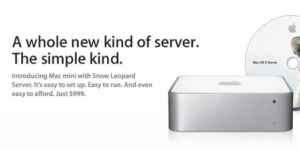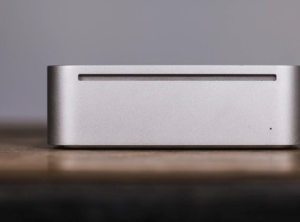“Lunch Box”for Apple: Evolutionary History of Mac mini
“The Mac mini is BYODKM”, Jobs once said at Macworld 2005, which caused a lot of confusion. “Bring Your Own Display, Keyboard, and Mouse”, he continued, “We supply the computer, and you supply the rest.”

The Mac mini was designed to lure switchers to the platform. A new customer could simply unplug their desktop PC and hook a new Mac mini up to their existing peripherals.
The original Mac mini started at just $499, making the machine the lowest-cost Mac Apple has ever sold.
For some long-time fans, the Mac mini brought back memories of the Macintosh LC, Apple’s low-cost Mac in the early 1990s.
The original Mac mini was powered by a 1.25 or 1.42 GHz G4 processor, came with a slow 4200 RPM hard drive and just 256 MB of RAM installed. Both initial models came with a Combo optical drive that could read DVDs and burn CDs. All of these were packed into a computer of just 2 inches height and 6.5 inches width and depth.
At this point the iMac and Power Mac were both sporting G5 processors, but the Mac mini’s reduced specs helped Apple hit that amazing price point. People started buying this cheap Mac as servers. They showed up in cars and alongside DVD players in home entertainment setups.
In September 2005, Apple silently revved the Mac mini to include a faster hard drive and CPU. The high-end model got a better GPU and a nicer SuperDrive (record DVD).
A. The Move to Intel
Like the iMac, the Mac mini’s move to Intel did not involve a radical redesign. Apple kept the case design intact, while adding two additional USB ports, audio in, Gigabit Ethernet and an infrared port for using the Apple Remote with Front Row.
All of these improvements came with an increase in price. The base model, which is the only Mac to have ever shipped with the Intel Core Solo processor, was $599. The high-end model, with a SuperDrive, Core duo CPU and a larger hard drive was $799. The Mini’s industrial design would remain in place for several more generations. The Late 2006 model brought a CPU speed increase, while the Mid 2007 machine came with 1 GB of RAM, larger hard drive and Core 2 Duo processor.
The Mid 2007 model was on sale for 19 months, leading many to worry that the Mac mini was going to be discontinued by Apple. Eventually, in March 2009, Apple refreshed the Mac mini again. CPU speed stayed the same, but the update brought Mini DisplayPort in addition to mini-DVI, making this the first Mac mini to support multiple displays.
B. Mac mini (Server, Late 2009)

In October 2009, Apple introduced a $999 Mac mini:
This machine came with Snow Leopard Server, a 2.53 GHz processor, 4 GB of RAM, and two500 GB hard drives. To accommodate the second drive, Apple removed the optical drive, leading to a one-off case that looks like a lunch box. I think this model shows that Apple had noticed how people were using the Mac mini by this point in the product’s life. The machine’s low price, small form factor and near-silent operation had made it first choice for users who needed a server in their home or office.
C. A “Big” Redesign
In the summer of 2010, Apple released a new Mac mini with a brand-new enclosure design carved out of a single slab of aluminum. It’s kind of like the original design got squished a bit.
The new design included a plastic bottom panel that could be removed with a simple twist. Upgrading the RAM had never been easier. Professional users could even replace the hard drive. Around back, the Mini picked an HDMI port as well as an SD card slot.
D. 2011 to Today
 A year later, the Mid 2011 Mac mini brought Thunderbolt, and the removal of the optical drive. A year later in 2012, the separate Server edition was quietly discounted.
A year later, the Mid 2011 Mac mini brought Thunderbolt, and the removal of the optical drive. A year later in 2012, the separate Server edition was quietly discounted.
Currently, the Late 2014 Mac mini is the newest model available. While it may look like the 2011 and 2012 machines, Apple made several changes:
- The RAM is no longer upgradable. That bottom panel still comes off, but the memory is soldered to the logic board.
- There is no longer a quad-core model, even as a build-to-order option. It’s dual-core all the way.
- The second 2.5-inch drive bay has been removed. Putting in a second drive just isn’t an option anymore.
E. The Future of the Mac mini
We don’t know if Apple will keep Mac mini or not, and the machine has not been updated in several years. With strategic shift to the mobile, Apple’s main focus is fully on the iOS device. Disregard for Mac products is making a lot of Mac users feel sidelined. What course to follow for the Mac mini, I believe Apple will give us an answer in this year.
